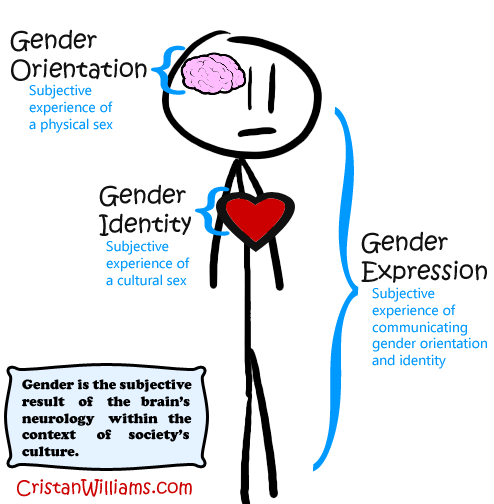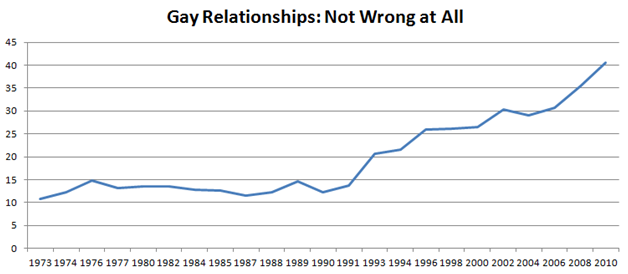 “Medically, Christine presents an almost classic case of the transsexual phenomenon or, in other words, a striking example of a disturbed gender role orientation.”
“Medically, Christine presents an almost classic case of the transsexual phenomenon or, in other words, a striking example of a disturbed gender role orientation.”
– Dr. Harry Benjamin, 1968
There was a time when we talked about gender in terms of an orientation. We don’t associate the term “orientation” with gender any longer and I think there’s a reason. Everyone from Virginia Prince to radical feminists jumped on the John Money bandwagon in the 1970s to collectively assert that gender is, in its entirety, merely a cultural creation. (But that’s a story for another post …)
Sexual Orientation, Identity and Expression
One’s sexual orientation might be homosexual, while their sexual identity could be heterosexual even though their sexual expression is bisexual. Sexuality is, in fact, multi-dimensional and not all of these dimensions are always aligned. (e.g., down-low).
When we talk about sexuality, we’re talking about these three dimensions. When someone says that their sexuality is hard-wired, they’re saying that they have an innate sense of their physical sexual response…

… that is oriented somewhere along a continuum. They’re saying that their orientation on this continuum is innate.
However, when we talk about the way we subjectively view our orientation, we move into the murky waters of a personal identity that can be affected by a number of factors including (but not limited to) pride and stigma; audacity and aversion; respect and shame; integrity and guilt; etc. How one might identify sexually may not actually reflect one’s sexual orientation. We call that experience, “being in the closet.” Likewise, one’s expression of their sexuality may not reflect the reality of their orientation (or even the way they personally identify, for that matter).
So-called “reparative therapy” is just an exercise in equivocation. When these organizations claim to change someone’s “sexuality,” they’re merely claiming to change one’s sexual expression and identity (usually through exposure to fear, shame and guilt). These organizations pretend that…
Identity + Expression = Orientation
… when the reality is:
Orientation + Identity = Expression
They believe that behavior drives orientation. That belief is false.
Gender Orientation, Identity and Expression
One’s gender orientation might be bigender, while their gender identity could be female even though their gender expression is masculine. Gender is, in fact, multi-dimensional and not all of these dimensions are always aligned. (e.g., third gender)
When we talk about gender, we’re talking about these three dimensions. When someone says that their gender is hard-wired, they’re saying that they have an innate sense of their physical sex…

… that is oriented somewhere along a continuum. They’re saying that their orientation on this continuum is innate.
However, when we talk about the way we subjectively view our orientation, we move into the murky waters of a personal identity that can be affected by a number of factors including (but not limited to) pride and stigma; audacity and aversion; respect and shame; integrity and guilt; etc. How one might identify their gender may not actually reflect one’s gender orientation. We call that experience, “being in the closet.” Likewise, one’s expression of their gender may not reflect the reality of their orientation (or even the way they personally identify, for that matter).
So-called “reparative therapy” is just an exercise in equivocation. When these organizations claim to change someone’s “gender,” they’re merely claiming to change one’s gender expression and identity (usually through exposure to fear, shame and guilt). These organizations pretend that…
Identity + Expression = Orientation
… when the reality is:
Orientation + Identity = Expression
The belief is that behavior drives orientation. That belief is false.
Gender Discourse: Poisoning the Well

[Use of sexual orientation, sexual identity and sexual expression in printed materials, 1960 – 2008]
The American Psychiatric Association removed homosexuality from the DSM in 1974. What we find is that discussing sexuality in terms of an expression or identity decreased as the public’s view of homosexuality as merely being a deviant lifestyle choice also decreased:

[Source: General Social Survey, NORC/University of Chicago, September 2011]
Imagine what sexuality discourse would be like (especially in politics) if the nuances of sexuality were only limited to identity and expression. Likewise, it seems that when the nuances of gender are limited to only identity and expression, discourse is poisoned.

[Cathy Brennan and Elizabeth Hungerford’s letter to the United Nations]
To be Clear
The issue for the MTF transsexual isn’t that we are a culturally constructed woman trapped in the physical body of a man; rather, a MTF transsexual’s subjective experience of their physical sex is female. When I assert that my subjective experience of my body has been always female, I mean exactly that. I only acquired a pervasive horror about my body when I learned around the age of 5 that my body shape was different from other girls. That particular horror is called dysphoria… as in, Gender Dysphoria. My issue wasn’t that I wanted to necessarily wear certain clothes or act a certain way; of course I wanted to be treated and identified as any other little girl in my culture, my dysphoria wasn’t situated around this secondary issue. I went to bed praying to have a god fix my body or allow me to die in my sleep not because my gender identity and expression wasn’t feminine; I began praying to die around the age of 5 because my experience was that my body betrayed me.
While some seem particularly invested in asserting that the issue of gender orientation for transsexuals is simply a question of cultural modality, all one need do to test the real-life efficacy of their theoretical framework is to look at the suicide rate among transsexuals living within systems which attempt to modulate gender orientation through controlling their gender identity and expression (BTW, in a study of 6,400 trans folks, the rate of attempted suicide was 41% as compared to 1.6% in cis folks). While transsexuals generally point to our innate gender orientation at an age long before we’ve developed a sophisticated vocabulary to describe our experience, there are many who seem perpetually poised to focus on, describe, critique and literally demonize the finger with which we point. In other words, RadFems and religious fundamentalists seem to forever miss the point. Our issue only becomes defined by gender identity and expression when people like RadFems and religious fundamentalists use gender identity and expression as a means to “cure” our innate gender orientation:
Nonsexist counseling is another direction for change that should be explored. The kind of counseling to “pass” successfully as masculine or feminine that now reigns in gender identity clinics only reinforces the problem of transsexualism. It does nothing to develop critical awareness, and makes transsexuals dependent upon medical-technical solutions. What I am advocating is a counseling that explores the social origins of the transsexual problem and the consequences of the medicaltechnical solution. – Raymond (1980), Technology on the Social and Ethical Aspects of Transsexual Surgery
There you have it, Raymond herself advocating for the development of a curative therapy model focused on gender identity and expression as a way to readjust gender orientation. If you want to know what happens to a someone who is forced to adopt a female identity and expression even though his orientation was male, I suggest you read up on the cautionary story of David Reimer.
For a more detailed description of what gender orientation is, please see this post [FIXED].
The Missing Link: Gender Orientation http://t.co/089LMQBg #girlslikeus #trans #transgender #gender
Via @cristanwilliams The Missing Link: Gender Orientation http://t.co/kZkcQ5iJ #girlslikeus #trans
A very thoughtful piece, Cristan. Thank you! I’ve long written about the confusion around terms that have very different meanings in the contexts of social identity vs inner personal experience. TS, TG, GI… all have this problem, with real consequences in medical and public policy and public perception of gender diversity. Your proposal to use separate terms deserves serious conversation.
The only little thing I would add is that both sexual orientation and gender identity are two-dimensional scales, with ‘both’ and ‘neither’ spaces. Bisexual people and asexual people are erased together on a linear Kinsey scale, just as bigender/CD people and queer-spectrum people are erased together on a linear Benjamin scale.
The Missing Link: Gender Orientation http://t.co/SN7iXatu
RT @AutumnSandeen: Via @cristanwilliams The Missing Link: Gender Orientation http://t.co/kZkcQ5iJ #girlslikeus #trans
The missing link: gender orientation http://t.co/psfMvjWw
Hmm… Interesting. http://t.co/yYpXAByS #Trans #GirlsLikeUs #LGBT (cc @TransNewsDaily )